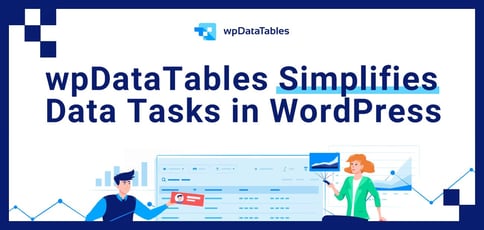
TL; DR: As a veteran of the WordPress plugin ecosystem, wpDataTables brings sophisticated data management functionality to the world’s most popular content management system. The plugin pulls together data from many different external sources and supports complex tabular and graphical visualization. With wpDataTables, site designers can display filterable information with point-and-click ease.
WordPress is currently the world’s most popular content management system, powering more than 41% of all websites and supporting a diverse plugin selection.
But the WordPress plugin ecosystem was just in its infancy when Alexander Gilmanov built wpDataTables in 2013.
“In those days, the market for paid WordPress tools was pretty young — especially the plugins market,” Alexander said. “There was a large range of themes, but we weren’t even looking at developing those at the time. And although I say we, back then it was just me, the developer.”
Using his background in full-stack development, Alexander created a wide range of web apps to embed large chunks of information within web pages. Those early apps were custom-built PHP solutions, so to automate the task, he developed a PHP library featuring an interactive table with three lines of code instead of 300.

“I started selling it once it became a well-developed tool,” he said. “That’s how I realized that people who avoid coding commonly use WordPress. So I created a plugin that wrapped this library in a user interface and allowed users to create tables from MySQL queries, Excel tables, Google spreadsheets, JSON, CSV, and XML — all just with a few mouse clicks.”
The plugin was well-received, and user requests began to pour in. Alexander improved the plugin by incorporating new features based on customer suggestions. These features included server-side processing with AJAX to display large tables, better responsiveness, different skins and customizations, front-end editing, and conditional formatting. As both the plugin and user base grew, Alexander also started building his team, first with support agents, then with developers.
“Today, wpDataTables has grown to a fully-featured data management and data representation tool bundled in a WordPress Plugin,” he said. “It is developed and maintained by several software engineers, QAs, support agents, and we still have lots of plans to further improve it.”
Thriving in a Sophisticated WordPress Plugin Market
The development of wpDataTables in some ways mirrors the development of the WordPress plugin ecosystem itself.
“Back in 2013 and 2014, it was more like an amateur marketplace of scripts. It felt like a niche for geeks and developers, not a broad audience market,” Alexander said. “Plugins back then were not really packed and presented as products, and the marketing was really basic. Nowadays, it is no longer an amateur space: it’s much harder — though not impossible — to gain traction.”
The WordPress plugin market has waxed and waned since those early days. At various times, big players arrived and consolidated, with marketing resources increasing significantly. Competition for the same types of plugins has also become fierce. WordPress is available for free, but many of its themes and plugins aren’t. And quite a few developers have built careers around them.

Take Automattic, the company that owns WordPress.com, for example. Automattic offers its own WordPress plugins that integrate well with the core platform. One such solution is WooCommerce, which currently dominates the shopping cart space. The well-known platform is free but requires costly premium extensions via plugin and theme vendors.
“Functionality-wise, WordPress tools have to look and feel much more like mobile apps nowadays,” Alexander said. “They must have a slick design and be genuinely easy to use, even by people who absolutely aren’t tech-savvy. Good plugins must anticipate the customer’s intentions as much as possible and not require mandatory and advanced configurations.”
Today’s plugins integrate with WordPress to drive deep extensibility for specific use cases while remaining easy to use. Some plugins simply enhance WordPress, while others create all-new functionality. The wpDataTables plugin falls into this latter category.
Developing Advanced Technology for Information Analysis
WordPress is a generic content management system optimized for web presentations. The software was originally a blog engine. Today, it can run entire companies via plugins for inventory, accounting, and human resources, among other purposes.
wpDataTables is optimized to display complex tabular datasets. Users can insert interactive data tables into a WordPress post or page, and those tables can be sorted, exported to a PDF, or limited through multicriteria filters. The plugin accepts data from various sources, including XML, CSV, and JSON files; PHP arrays; Google spreadsheets; and MySQL queries. The tables are scrollable and support column totals, row groups, inline edits, cell merges, and basic row-level data security.
“The key is that wpDataTables allows for quite advanced tasks, such as displaying or even editing data from remote database servers on a WP website,” Alexander said. “In the past, such functionality required advanced development work or expensive database solutions. Now it’s available for anyone with a basic WordPress website.”
Users can leverage the plugin to present raw data, combine data, apply complex sorting rules, and deliver summaries of information in a visually appealing format. Display types include tabular lists and a variety of common charts.
“Our favorite aspect of wpDataTables is the flexibility and the huge variety of ways in which it is useful for people and businesses,” Alexander said. “There is a wide range of use cases. One customer in the U.S. uses the tool to display real-time data from agricultural sensors and provide alerts with critical information. A customer in the central bank of one African country, on the other hand, uses it to display official currency rates on its website.
wpDataTables: Intuitive, Powerful Data Management Tools
Over the last few years, the WordPress plugin market has become significantly more competitive, with more sophisticated tools and an increase in mergers and acquisitions. Whereas early plugins were often hobbyist affairs, many modern WordPress plugins come from larger corporate interests with major marketing budgets.
Still, wpDataTables manages to stand out among its competitors through advanced functionality. With wpDataTables, a WordPress administrator can turn the content management system into a full-featured analytics portal. The plugin supports a variety of external data sources and provides multiple display options. It also provides tools for data editing, includes basic security features, and offers the flexibility to sort and filter data in complex ways.
The next major push for Alexander and his team relates to ongoing ease-of-use enhancements.
“It will become even easier to use for the typical use cases,” he said.
Alexander said WordPress admins save both time and money. To enjoy the functionality of wpDataTables without the plugin, admins would have to write several hundred lines of code for each table or graph insertion. With the plugin, complex data visualizations are point-and-click simple.
Like many WordPress plugins, wpDataTables supports both a free and a paid solution.
“We plan to evolve the free tool a lot because we wish to contribute to the WordPress community that has been so great to us,” Alexander said.
HostingAdvice.com is a free online resource that offers valuable content and comparison services to users. To keep this resource 100% free, we receive compensation from many of the offers listed on the site. Along with key review factors, this compensation may impact how and where products appear across the site (including, for example, the order in which they appear). HostingAdvice.com does not include the entire universe of available offers. Editorial opinions expressed on the site are strictly our own and are not provided, endorsed, or approved by advertisers.
Our site is committed to publishing independent, accurate content guided by strict editorial guidelines. Before articles and reviews are published on our site, they undergo a thorough review process performed by a team of independent editors and subject-matter experts to ensure the content’s accuracy, timeliness, and impartiality. Our editorial team is separate and independent of our site’s advertisers, and the opinions they express on our site are their own. To read more about our team members and their editorial backgrounds, please visit our site’s About page.

